
In a recent blog I wrote about the fallen giants – some of the large Scots pines (Pinus sylvestris) and oaks (Quercus petraea) that were blown down by the powerful storm that hit Dundreggan on the night of 5th December 2013. Since then, we’ve continued to find other trees throughout the woodland on the estate that were either uprooted and blown over, or had substantial limbs broken off them. This blog entry is about one of those – an aspen tree (Populus tremula) – that lost part of a major branch in the storm.


It’s a tree with multiple trunks, and is growing on the edge of the gully of the Allt – what we commonly the Aspen Burn, because it has several aspen stands along it, including this one. It’s not far from the buildings at Dundreggan, and I’ve known the tree since July 2005, when I began visiting Dundreggan as part of the lead up to our purchase of the estate.

I’ve photographed this aspen intermittently over the years since then, and have got to know the tree quite well, so it was something of a shock to discover that it had sustained this damage in the storm. However, it has prompted me to tell what I know of the tree’s story in words and images now, so this is my personal tribute to this particular aspen. It’s only a partial picture, though, as there is certain to be much more about the tree that I haven’t learned yet.



When I first saw this aspen in 2005, I was interested to note that it had some brackets of the aspen bracket fungus (Phellinus tremulae) on it. This is a rare species that was only recorded in Scotland for the first time in 2000, but has subsequently been found to be relatively widespread on aspen in the Highlands. However, it is mainly recorded from aspens in the eastern part of the country, and this may be the most westerly known occurrence of it.

This bracket fungus is the most serious pathogenic species affecting aspens, and weakens the tree, potentially leading to its death. Its fruiting bodies often appear just under where a side branch has emerged from the trunk, and the top surface of the bracket usually has radial cracks on it. Both of these features can be seen in the photograph here, and help to distinguish it from the tinder fungus (Fomes fomentarius), another bracket fungus that normally occurs on birch trees (Betula spp.), but occasionally is found on aspen as well.
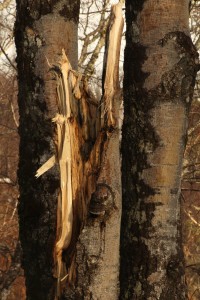
Looking at where the one trunk of the tree had been snapped off in the storm on the 5th of December, I saw immediately that it was right next to one of these fungal brackets.


To me, this clearly showed that the tree trunk had been weakened by the presence of the fungus, the main part of which would have been consuming and breaking down the structure of the wood in the trunk during the past 9 years, since I first saw the brackets in 2005. It’s likely in fact that the fungus had been present in the tree for at least several years before that, going by the size of the fruiting bodies in 2005. Although this is a loss for this particular tree, it is nevertheless a natural phenomenon, and, as always in Nature, there are other species that take advantage of such situations and circumstances. In doing some research about the effects of Phellinus tremulae last year, I had come across some references to it in North America, where it occurs on the closely-related quaking aspen (Populus tremuloides). It had been documented there that aspen trees affected by the fungus were preferentially selected by woodpeckers as nesting sites, presumably because the weakened nature of the infected trees made it easier for the woodpeckers to hollow out cavities in the trunks.
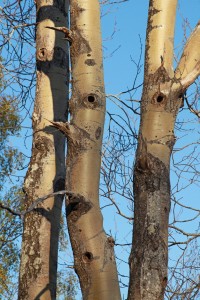
This fact was very interesting and illuminating to me, and it began to build up a picture for me of the inter-related parts of the web of life surrounding aspen trees in Scotland. That was because this tree at Dundreggan, with the storm-shattered trunk and the bracket fungus on it, also contained a number of nest holes made by the great spotted woodpecker (Dendrocopos major)! I’d seen these a couple of years ago, and the photographs here were taken in May 2012, when I, and the tree, were quite oblivious to the fate that awaited it in December 2013!



About 200 metres to the east of this aspen tree at Dundreggan, there’s another stand of aspens, in that case consisting of over a dozen large trees. They are notable for having a lot of distinctive burls on some of the trees, and several also have the brackets from the aspen bracket fungus (Phellinus tremulae) fruiting on them. It was in one of those trees that I was able to get some good photographs of a pair of great spotted woodpeckers bringing food to their chicks in May 2006.

In the same stand of aspen trees, but in a different individual tree to the one where these woodpeckers raised their chicks, a colony of wild honey bees (Apis mellifera) have been living for the past three years at least. They are occupying a cavity in a tree which I had originally thought was an abandoned woodpecker nest site, but the cavity entrance looks like it may be too small to have been made by a great-spotted woodpecker, and could just be where a dead branch formerly emerged from the trunk.
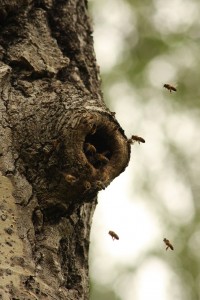
In any event, I’ve been observing the honey bees there each year since we first discovered them, in the summer of 2011. On sunny days, large numbers of bees fly in and out of the cavity entrance, transporting pollen and nectar to the young in their nest.

Here’s some video footage of the bees:
[jwplayer config=”alan29may” file=”http://www.alansblog.org.uk/alan17apr14.mp4″ html5_file=”http://www.alansblog.org.uk/alan17apr14.mp4″ image=”http://www.alansblog.org.uk/alan17apr14-preview.jpg”]
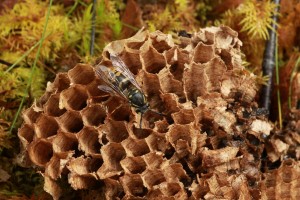
Back at the other aspen stand, where one of the trunks was shattered by the storm in December 2013, I had made an interesting discovery back in September 2012. Directly underneath the tree, in the gully below, I found some fragments of honeycomb lying on the ground. There were some common wasps (Vespula vulgaris) crawling over these, undoubtedly attracted by the honey in the cells.

There were larvae visible in some of the cells, so I suspect the honeycomb had not been on the ground for long. What had happened, I wondered? My best guess was that one of the abandoned woodpecker cavities in the aspen above had been colonised by bees, as in the other aspen stand, and that perhaps a pine marten (Martes martes) had raided the nest, to steal the honey. In doing so, some of the honeycomb had fallen to the ground, where the wasps were taking advantage of it opportunistically. This is just speculation on my part though, and the actual cause of the situation will never be known for certain. However, it does add some other interesting links to the chain of life and death associated with this aspen tree!

Over the years I’ve often looked at the leaves of this particular aspen tree, and on several occasions I’ve noticed swellings on the leaf stems or petioles. These are galls induced by a midge (Contarinia petioli), and the larva of the midge is able to develop inside the gall, safe from predators, and feeding on special nutritive tissue that the tree is induced to provide there.

No one really knows for certain the exact nature of the process by which the midge induces the tree to produce both this abnormal growth, and the nutritive tissue that the midge larva feeds on – there’s a great deal still to be learned about the whole process of gall formation.

On this same tree I’ve sometimes seen a small metallic-looking beetle – a species of leaf beetle (Phratora vitellinae). About 3-4 mm in length, this beetle is shiny and dark in coloration, often looking black, or occasionally a dark copper colour, as in this photograph. It’s quite common in our area, and I frequently see it on aspen leaves, especially in the early summer.

It feeds on willows (Salix spp.) as well as aspens, but I’ve usually seen it on aspens – perhaps that’s just because I spend more time looking at aspens than willows though! They are one of the more attractive of the smaller beetles I’ve come across in the Caledonian Forest, and I’ve been curious about them for quite a few years. I’ve also photographed them for over a decade, and I’ve been able to document almost all of their lifecycle.

Adults emerge in spring, soon after the new leaves of the aspens open out. This can be quite late, as in some years the aspens only get their leaves in our area at the beginning of June – it’s usually the last tree to come fully into leaf. The beetles will mate soon afterwards – the photo here was taken on 24th June in 2013 – and the females lay their eggs on the underside of an aspen leaf.

I suspect that a single female will lay eggs on the underside of several leaves, as I’ve found eggs on a number of leaves close together, but only one adult in the vicinity. The eggs are laid in neat geometric rows clustered together, and are a translucent creamy-white colour. I don’t what the incubation period is, but I assume it’s only a matter of a few days before the larvae hatch out of the eggs and begin feeding.

The larvae are black in colour, with a geometric pattern of raised spots on their bodies. As they get larger, their bodies turn more whitish in colour, with the spots remaining black. They feed gregariously, side by side, progressing across the surface of a leaf like a hungry army, stripping everything bare as they go. In their wake, they leave a brown skeletal-like surface, with all the chlorophyll-rich nutritive plant material removed.

When I first came across these larvae feeding on the underside of an aspen leaf, I wasn’t sure what species they were, although I suspected it was likely they were of the leaf beetle (Phratora vitellinae). In the summer of 2013, when I found some good colonies of the larvae, I collected a few and took them home, where I reared them on leaves from an aspen tree in my garden. In due course, one of them pupated successfully, and I sent the adult off to a beetle expert, who duly confirmed that it was indeed Phratora vitellinae.
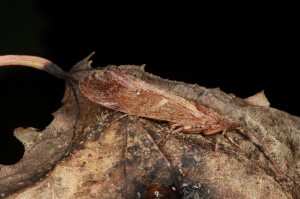
There’s another aspen stand just a little further upstream on the Aspen Burn from this one with the storm damage, and in July 2011, I found a most unlikely insect on the tree. My attention was drawn to two brown leaves (unusual for July) that had been sewn together, and when I gently pulled them apart I found an adult caddisfly (Glyphotaelius pellucidus) inside. I was able to get this identified by an expert, and I assume that the caddis larva had climbed out of the water to pupate, sewing the leaves together to do so, out of sight of predators.

This was another example of the remarkably varied life that is associated with aspen trees. While much of that depends on the living tree itself, there’s also a whole suite of rare invertebrates, known as saproxylic insects, that feed on dead wood of aspen trees. Some of these are very rare indeed now in Scotland, because of the relative paucity of aspen stands, and the consequent shortage of dead aspen wood for them to breed in. The broken trunk of the aspen tree that forms the main subject of this blog may be a loss for the tree itself, but nevertheless over the course of the next few years, it will provide the habitat for some of these saproxylic insects. As such, it will continue to be part of the never-ending cycle of life, even though the trunk itself will rot away and disappear entirely during the course of a number of years.

In 2001 we commissioned a survey of dead aspen wood in Glen Affric by two members of the Malloch Society, a group of entomologists who specialise in these saproxylic insects. Although they didn’t find evidence of the rarest of these insects – the aspen hoverfly (Hammerschmidtia ferruginea) – they did find the larva of another slightly more common hoverfly (Xylota tarda), which is also dependent on dead aspen wood as its food source.

We haven’t had a comparable survey of dead aspen wood carried out on Dundreggan yet, but I hope to organise one in the next year or two. In the meantime, I’ll continue to appreciate the interplay of life and death in this aspen tree, and will finish now with some photos of it, taken in the years when it was intact, before the storm.


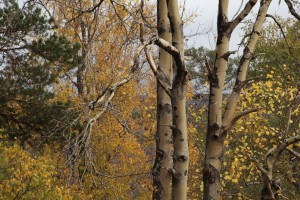
Hello Alan,
I think we met once before at Findhorn (I’m a long-standing friend of Sian Mackay).
One of my writing commitments is a monthly nature column in the Scots Magazine. They sent me your 25th anniversary press release and suggested that I might like to make Trees for Life the basis of an article, which I am more than happy to do. Having just read your aspen tree blog (which I greatly enjoyed), and having written about the woodland west of Loch Ness at some length in my book The Great Wood, I though it might be nice to have a chat. So I wonder how your fixed over the next week or so, as I’m planning a trip over to Sandaig soon, and thought I could combine the two.
Do let me know, and keep up the fine work,
Good wishes,
Jim Crumley